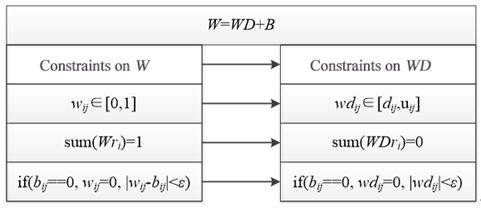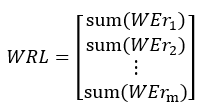6.4 Linear fitting under mass conservation constraints
The bounded linear fitting method ensures that yields remain within defined boundaries during fitting, and the error limitation method prevents excessive deviation from the baseline yield. However, Constraint 2—that the sum of yields for all outputs from a given input must equal 1—is still not satisfied. This section presents a linear transformation method to satisfy this constraint, thereby obtaining the final yield, W.
The baseline output matrix, denoted YB, is obtained using the input matrix X and the baseline yields B:
YB=X*B
The deviation matrix, E, is obtained by comparing Y and YB:
E=Y-YB
The deviation yield boundary BD is calculated using the error limitation method:
BD=bd(X,Y,B,rg)
where bd(…) represents the error limitation method, and rg is the boundary adjustment ratio, rg∈[0,1].
The bounded linear fitting algorithm is used to fit X and E, obtaining the deviation yields, denoted WE:
WE=BDfit(X,E,BD)
where BDfit(…) is the bounded linear fitting algorithm.
WE does not guarantee that W satisfies Constraint 2. However, a linear transformation can be applied to obtain the best deviation yield, WD, that satisfies the constraint while minimizing the loss of accuracy.
WD=L(WE)
where L(…) represents a certain linear transformation.
We expect that summing WD and the baseline yield B will obtain the yield W. Consequently, the constraints on W are transformed into constraints on WD, as shown in the figure below.

dij and uij are the upper and lower bounds, respectively.
Ideally, the row sum WRL of WE is 0, which means that each column of WE has a linear relationship with the sum of the other columns.
This linear relationship can be used to perform a linear transformation on WE to obtain WD that satisfies Constraint 2.
Assume the WE matrix is as follows:

(1) Calculate the row sums, WRL, of WE:

(2) Calculate the matrix WS, formed by the sums of the vectors in WE excluding the j-th column:

(3) Obtain WD through linear transformation:
WEcj, WScj and WRL have the following relationship:
WEcj+WScj=WRL
Given that WEcj represents the optimal yield for the j-th column as determined by the bounded linear fitting algorithm, it follows that WScj=WRL-WEcj is also accurate. Apply the following linear transformation to obtain WD’:
WD’cj=WEcj*(n-1)/n+WScj*(-1/n)
=WEcj*(n-1)/n+(WEcj-WRL)/n
=WEcj-WRL/n
where WD’cj denotes the element in the j-th column of the linearly transformed matrix WD’.
After linear transformation, it is equivalent to subtracting the row mean WRLi from a certain deviation yield weij:

wd’ij=weij-WRLi/n
WD’ satisfies Constraint 2, but it is still necessary to verify whether WD’ allows W to satisfy Constraint 1, i.e., whether wij=wd’ij+bij ∈[0,1].
If W satisfies constraint 1, then the fitting is complete:
WD=WD’
If there exists a wd’ij such that wij ∉[0,1], then the transformation rule needs to be adjusted.
Assume that there are z columns in WE that have elements that do not satisfy the constraint:
WE=[WEc1,WEc2,…,WEc(1),…,WEc(z),…,WEcn]
where [WEc(1),…,WEc(z)] are the columns of deviation yield that, even after transformation, still do not meet the constraint. That is, there exists:
wei(p)+bi~(p)~∉[0,1],p∈[1,z]
The previous linear transformation was WD’cj=WEcj*(n-1)/n+WScj*(-1/n). The transformation coefficients for both were fixed at (n-1)/n and (-1/n), but because the constraint cannot be satisfied, this cannot be used. Another approach is to fix the transformation coefficient of WEcj to 1 and solve for the coefficient of WScj using an equation.
Let the coefficient vector for WScj be vector A, as given by the equations below:

where WDcj is the j-th column element of the deviation coefficient matrix WD.
The coefficient vector A can be obtained from equations ① and ②. Additionally, the yield weij must also equal 0 when the baseline yield bij equals 0.
Solving the equations obtains the vector A:

After obtaining vector A, substitute it into Equation ① to get WDcj.
At this point, it is necessary to re-verify whether WD allows W to satisfy Constraint 1. If it does, the calculation is complete, and WD is obtained. Otherwise, the columns that do not satisfy the constraint condition must be added to the set [WEc(1),…,WEc(z)], and the above method is repeated until all wij satisfy Constraint 1 (wij=(wdij+bij)∈[0,1]), yielding WD.
Finally, add the base yield matrix B to WD to obtain W:
W=B+WD
SPL routine:
| A | B | C | D | |
|---|---|---|---|---|
| 1 | [[30,8],[31,7],[38,10]] | /X | ||
| 2 | [[2,13,23],[3,15,20],[11,13,24]] | /Y | ||
| 3 | [[0,0.5,0.5],[0.55,0.05,0.4]] | /B | ||
| 4 | 0.1 | /rg | ||
| 5 | =mul(A1,A3) | /X*B | ||
| 6 | =A2.(~–A5(#)) | /E | ||
| 7 | =bd(A1,A2,A3,A4).(.(.(round(~,3)))) | /BD | ||
| 8 | =A6.~.((idx=#,bdfit(A1,A6.([~(idx)]),A7.(~(idx))).conj())) | /WET | ||
| 9 | =transpose(A8) | /WE | ||
| 10 | =func(A12,A9,A3) | /WD | ||
| 11 | /Linear transformation; parameters: WE, B | |||
| 12 | func | |||
| 13 | =A12.(~.count(~==0)) | /Number of zeros in each row of WE | ||
| 14 | =A12.~.len() | /Number of outputs | ||
| 15 | =A12.((s=~.sum(),ind=#,~.(if(~==0,0,s/(B14-B13(ind)))))) | /Calculate mean per row | ||
| 16 | =A12.(~–B15(#)) | /weij-WRLi/n | ||
| 17 | =B12.(~++B16(#)) | /W=WD’+B | ||
| 18 | =transpose(B17) | |||
| 19 | =B18.pselect@a(~.pselect(~<0||~>1)>0) | /Record column indices where WD’ violates constraints | ||
| 20 | if B19.len()==0 | return B17 | /If no violations, return W | |
| 21 | else | =func(A24,A12,B12,B19) | /If violations, adjust transformation rule | |
| 22 | return C21 | |||
| 23 | /Recursive elimination of elements violating Constraint 2 | |||
| 24 | func | |||
| 25 | =B24.~.len() | |||
| 26 | =A24.(~.sum()) | /WRL | ||
| 27 | =A24.((w=~,w.((ind=#,if(~==0,0,w(to(B25).delete(ind)).sum()))))) | /WS | ||
| 28 | =A24.(~.pselect@a(~==0)) | /Indices where the yield is 0 in WEri | ||
| 29 | =B28.(~&C24) | /Indices that are zero and violate constraints | ||
| 30 | =B26.(~/((B25-B29(#).len()-1)*~+A24(#)(B29(#)).sum())) | /ai | ||
| 31 | =A24.((ind=#,~.(if(B29(ind).pos(#)>0,0,B30(ind))))) | /A | ||
| 32 | =B27.(~**B31(#)) | /A**WScj | ||
| 33 | =A24.((idx=#,if(B31(#).id()==[0],B32(#),~–B32(#)))) | /WD | ||
| 34 | =B24.(~++B33(#)) | /B+WD | ||
| 35 | =transpose(B34) | /WT | ||
| 36 | =B35.pselect@a(~.pselect(~<0||~>1)>0) | /Re-check for any yields violating constraints | ||
| 37 | if B36.len()==0 | return B34 | /If no violations, return W | |
| 38 | else | =C24=C24&B36 | /If violations, record them | |
| 39 | =func(A24,A24,B12,C24) | /WD | ||
bd(…) in cell A7 is the error limitation method used to calculate the deviation yield boundary BD.
bdfit(…) in cell A8 is the bounded linear fitting algorithm.
The code block in cell A12 performs a linear transformation on WE.
The code block in cell A24 performs a transformation on WD’.
Calculation result example:
Input X:

Output Y:

Baseline yield B:

Boundary adjustment ratio rg:
rg=0.1
Calculated boundary BD:

Final yield W:

Let’s start by looking at the MSE for each output using the baseline yield B:
MSE1=12.24
MSE2=16.24
MSE3=8.98
where MSEj is the MSE for the j-th output.
Now, let’s examine the MSE for each output using W:
MSE1=10.97
MSE2=5.13
MSE3=3.86
It is evident that the fitted W yields a better result.
SPL Official Website 👉 https://www.esproc.com
SPL Feedback and Help 👉 https://www.reddit.com/r/esProcSPL
SPL Learning Material 👉 https://c.esproc.com
SPL Source Code and Package 👉 https://github.com/SPLWare/esProc
Discord 👉 https://discord.gg/sxd59A8F2W
Youtube 👉 https://www.youtube.com/@esProc_SPL


